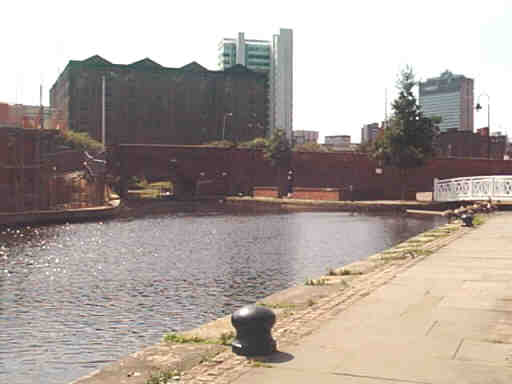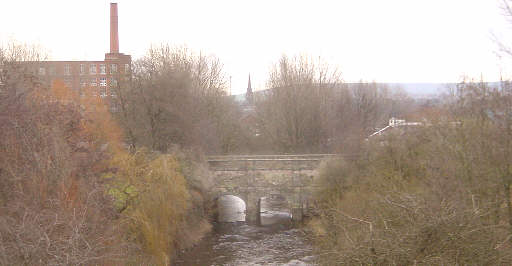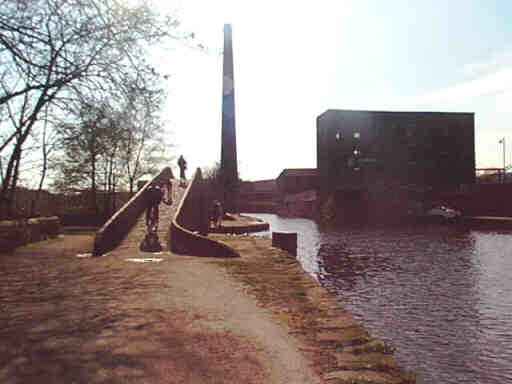The Ashton Canal runs eastwards from Manchester to Ashton under Lyne. This page gives some historical background to the canal, with a few photographs.
Following the success of the Duke of Bridgewater's canal in moving coal from his mines to Manchester and other developing industrial areas, a group of mine owners around Ashton and Oldham saw the potential for doing the same thing themselves.
In 1792 a group of shareholders, including these mineowners, put forward a proposal for an Act of Parliament to establish what was originally to be called the Manchester, Ashton under Lyne and Oldham Canal.
This was approved and the original scheme was completed in 1796, running from a large basin behind what is now Piccadilly Station in Manchester, climbing gradually eastwards via 18 locks to Fairfield, Droylsden. From there one level section continued eastward to Whitelands Basin, Ashton under Lyne, while another arm headed north through what is now Daisy Nook, climbing another eight locks to Hollinwood, with a branch running east from Daisy Nook towards Park Bridge. A short arm from Portland Basin crossed the River Tame to Dukinfield. A year later an additional branch from Clayton to Stockport was opened.
When this network opened it was isolated from the other canals then in existence. This suited the original purpose of the canal, which was to transport coal to Manchester, but as the Huddersfield and Peak Forest Canals were developing there was growing pressure for through trade to be allowed. The Rochdale canal was not completed between Ancoats and the Bridgewater Canal at Castlefield, Manchester, until 1799 - the Duke of Bridgewater having for some years refused to allow the Rochdale company to have a junction with the Bridgewater Canal. The short link between Ashton Canal Basin at Piccadilly and the Rochdale Canal was not opened until 1800, when disputes about canal tolls and responsibility for paving the streets around the basins were resolved.

Looking westwards towards the former Ashton Canal Basin near Piccadilly, Manchester, from Paradise Wharf.
Relationships with the Rochdale Canal Company were not always favourable in the early days. Due to a loophole in the law allowing mine owners to build their own short branches, a private extension of the Hollinwood branch, known as the Werneth Canal, ran north from Hollinwood for a mile to Old Lane, to serve the New Engine Colliery there. The Rochdale company had originally planned a branch running towards Oldham and so felt that the viability of their plan had been undermined by devious means. Proposals in 1791 and 1806 to link the two canals between Hollins Road and Henshaw Lane were never followed through.
The main line of the canal between Manchester and Ashton was 6.75 miles long. The total mileage of the Hollinwood and Stockport branches along with the other shorter branches was more than double this! This total would have become higher still, but a 3 mile arm from the Stockport branch eastwards towards Beat Bank, Haughton Green, was abandoned before being completed.
The Peak Forest and Huddersfield Canals were originally conceived as extensions to the Ashton Canal. The company was in danger of taking on too much at once so separate companies were formed to build these canals, although they had many shareholders in common and usually worked co-operatively with each other.
The Peak Forest Canal, opened in 1800, joined the Ashton Canal by way of the Dukinfield spur across the aqueduct over the Tame at Portland Basin. The Peak Forest ran to basins at Bugsworth and Whaley Bridge to which railways brought stone from the Peak District quarries. Later the Macclesfield Canal linked the Peak Forest to the Trent and Mersey Canal, which in turn linked to the Bridgewater Canal, thus forming what is now known as the Cheshire Canal ring.

Dukinfield Aqueduct, linking the Peak Forest Canal to the Ashton Canal.
In the first half of the nineteenth century the Ashton Canal prospered, carrying coal to the mills and coal merchants along the line, bringing in raw materials to the mills and taking out the manufactured products, transporting stone for building and road construction and even carrying passengers. A lucrative side-line was the selling of water to the owners of steam engines. Traffic was so great that the company started to convert the locks into double (twin) locks, although they only completed the two Fairfield locks, 17 and 18.
However, the coming of the Railway Age saw a loss of trade for the canals. Even so, the Ashton Canal took advantage of new opportunities and when the Sheffield, Ashton under Lyne and Manchester Railway opened "Ashton under Lyne and Hooley Hill" railway station at Guide Bridge in 1844, every train was met by a swift horse drawn fly boat to whisk passengers the rest of the way to Ashton. A few years later, however, a branch railway to Stalybridge included a new station at Park Parade, Ashton, making the boat service redundant. In 1848, the railway, now the Manchester, Sheffield and Lincolnshire Railway, bought the Ashton, Peak Forest and Macclesfield Canals in order to feed goods into their railway system.

The Peak Forest Canal joins the Ashton Canal at Portland Basin, Ashton under Lyne.
Large quantities of coal and other goods were still being carried on the canal up until the first decades of the twentieth century, but the smaller mines became unproductive or suffered subsidence and closed. The textile industry was also beginning a decline. The quantity of goods carried on the Ashton Canal fell from 50,000 tons in 1933 to just 7 tons in 1955.
The Hollinwood Branch closed in sections between 1932 and 1961. The Stockport Branch was closed in 1962 and the Ashton Canal, by now virtually un-navigable, looked set to follow.
However, in 1964, the Peak Forest Canal Society was formed and, with the Inland Waterways Association, fought to keep the Peak Forest and Ashton Canals open and to restore them. In 1968, 600 volunteers cleared 2,000 tons of rubbish from the section of canal between Clayton and Droylsden. Unhappily, this action was condemned by the Droylsden council which prefered to see the canal closed and culverted.
The council believed the cost of culverting the 6.75 miles of canal to be £90,000. However, when a 3 mile stretch of the Rochdale Canal was culverted the cost turned out to be £400,000, which would suggest the cost of culverting the Ashton Canal to be nearer a million.
Eventually, in 1971, the canal was given a reprieve and restoration was approved. In 1972, a thousand volunteers from all over the country descended on the canal. Over the next two years with volunteer help and mechanical plant, the whole canal was cleared and restored. It was re-opened for navigation in April 1974, ironically, at the same time that Droylsden Council ceased to exist.
Since then, the use of the canal network for leisure has developed and the Ashton Canal is an important link in the popular Cheshire Ring. The Huddersfield Narrow Canal has been restored and re-opened in 2001, which will increase further the use of the Ashton Canal.
Canal-side properties are being re-developed and the attractive Piccadilly Village project has opened alongside the canal in Manchester. The Ashton Canal Warehouse has now been re-built to house the Portland Basin Museum. The canal towpaths are increasingly popular for walking, cycling and fishing. After a period of neglect and dereliction, the future of the Ashton Canal now seems to be secure, not only as a popular navigation, but also as a linear park.
New societies have now been formed to promote the restoration of the Hollinwood and Stockport branches of the Ashton Canal.

New canalside development at Piccadilly Village, Manchester.